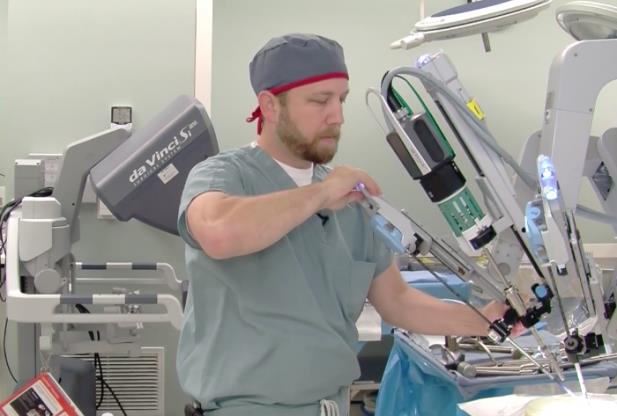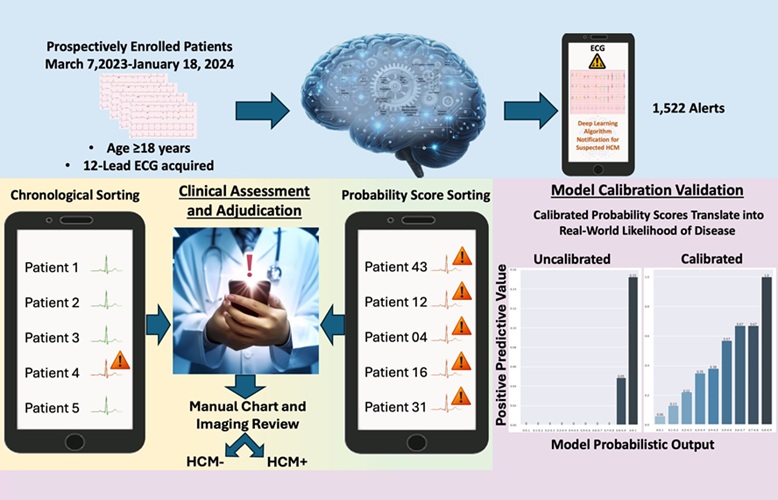Robotic Surgery Technique Treats Head and Neck Tumors 
|
By HospiMedica International staff writers Posted on 28 Dec 2014 |

Image: Dr. Abie Mendelsohn manipulating the da Vinci surgical robotic system (Photo courtesy of UCLA).
A pioneering robotic surgery technique helps surgeons remove tumors in previously unreachable areas of the head and neck.
Researchers at the University of California Los Angeles (UCLA; USA) refined, adapted, and advanced the transoral robotic surgery (TORS) technique to allow surgical instruments and three dimensional (3D) imaging tools to reach and operate safely within the parapharyngeal space, a pyramid-shaped area that lies near the base of the skull connecting several deep compartments of the head and neck. It is lined with many large blood vessels, nerves, and complex facial muscles, making access to the space via traditional surgical options often impossible or highly invasive.
The researchers provided a detailed technical description of the new technique, which was applied in a patient that developed compressive symptoms from a 54×46 mm parapharyngeal space lipomatous tumor. The patient was referred by his primary otolaryngologist due to poor open surgical access to the nasopharyngeal component of the tumor. Using the modified TORS technique, an assisted resection of the parapharyngeal space mass was performed, utilizing 97 minutes of robotic surgical time. The study was published online ahead of print in November 15, 2014, in Head & Neck.
“This is a revolutionary new approach that uses highly advanced technology to reach the deepest areas of the head and neck,” said lead author Abie Mendelsohn, MD, director of head and neck robotic surgery at UCLA. “Patients can now be treated in a manner equivalent to that of a straightforward dental procedure and go back to leading normal, healthy lives in a matter of days, with few or even no side effects.”
The researchers used the da Vinci system, a product of Intuitive Surgical (Sunnyvale, CA, USA), which consists of a surgeon’s console and a patient-side cart with four interactive robotic arms controlled from the console; three of the arms are for tools, while the fourth is for an endoscopic camera with two lenses that gives the surgeon full stereoscopic vision. The system scales, filters, and translates the surgeon's hand movements into more precise micromovements of the instruments, which operate through small incisions in the body.
Parapharyngeal space tumors have traditionally been approached via transcervical skin incisions, or by splitting the mandibula. Chemotherapy and radiation therapy are also often required, further complicating recovery and potentially putting patients at risk for serious, even lethal, side effects.
Related Links:
University of California Los Angeles
Intuitive Surgical
Researchers at the University of California Los Angeles (UCLA; USA) refined, adapted, and advanced the transoral robotic surgery (TORS) technique to allow surgical instruments and three dimensional (3D) imaging tools to reach and operate safely within the parapharyngeal space, a pyramid-shaped area that lies near the base of the skull connecting several deep compartments of the head and neck. It is lined with many large blood vessels, nerves, and complex facial muscles, making access to the space via traditional surgical options often impossible or highly invasive.
The researchers provided a detailed technical description of the new technique, which was applied in a patient that developed compressive symptoms from a 54×46 mm parapharyngeal space lipomatous tumor. The patient was referred by his primary otolaryngologist due to poor open surgical access to the nasopharyngeal component of the tumor. Using the modified TORS technique, an assisted resection of the parapharyngeal space mass was performed, utilizing 97 minutes of robotic surgical time. The study was published online ahead of print in November 15, 2014, in Head & Neck.
“This is a revolutionary new approach that uses highly advanced technology to reach the deepest areas of the head and neck,” said lead author Abie Mendelsohn, MD, director of head and neck robotic surgery at UCLA. “Patients can now be treated in a manner equivalent to that of a straightforward dental procedure and go back to leading normal, healthy lives in a matter of days, with few or even no side effects.”
The researchers used the da Vinci system, a product of Intuitive Surgical (Sunnyvale, CA, USA), which consists of a surgeon’s console and a patient-side cart with four interactive robotic arms controlled from the console; three of the arms are for tools, while the fourth is for an endoscopic camera with two lenses that gives the surgeon full stereoscopic vision. The system scales, filters, and translates the surgeon's hand movements into more precise micromovements of the instruments, which operate through small incisions in the body.
Parapharyngeal space tumors have traditionally been approached via transcervical skin incisions, or by splitting the mandibula. Chemotherapy and radiation therapy are also often required, further complicating recovery and potentially putting patients at risk for serious, even lethal, side effects.
Related Links:
University of California Los Angeles
Intuitive Surgical
Latest Surgical Techniques News
- DNA Origami Improves Imaging of Dense Pancreatic Tissue for Cancer Detection and Treatment
- Pioneering Sutureless Coronary Bypass Technology to Eliminate Open-Chest Procedures
- Intravascular Imaging for Guiding Stent Implantation Ensures Safer Stenting Procedures
- World's First AI Surgical Guidance Platform Allows Surgeons to Measure Success in Real-Time
- AI-Generated Synthetic Scarred Hearts Aid Atrial Fibrillation Treatment
- New Class of Bioadhesives to Connect Human Tissues to Long-Term Medical Implants
- New Transcatheter Valve Found Safe and Effective for Treating Aortic Regurgitation
- Minimally Invasive Valve Repair Reduces Hospitalizations in Severe Tricuspid Regurgitation Patients
- Tiny Robotic Tools Powered by Magnetic Fields to Enable Minimally Invasive Brain Surgery
- Magnetic Tweezers Make Robotic Surgery Safer and More Precise
- AI-Powered Surgical Planning Tool Improves Pre-Op Planning
- Novel Sensing System Restores Missing Sense of Touch in Minimally Invasive Surgery
- Headset-Based AR Navigation System Improves EVD Placement
- Higher Electrode Density Improves Epilepsy Surgery by Pinpointing Where Seizures Begin
- Open-Source Tool Optimizes Placement of Visual Brain Implants
- Easy-To-Apply Gel Could Prevent Formation of Post-Surgical Abdominal Adhesions
Channels
Critical Care
view channel
Smart Bandage Monitors Chronic Wounds in Human Patients
A future smart bandage, envisioned as a "lab on skin," could assist both patients and caregivers by not only monitoring chronic wounds but also delivering treatment and accelerating the healing process... Read more
AI Identifies Patients with Increased Lung Cancer Risk Up To 4 Months Earlier
Earlier diagnosis plays a crucial role in improving the prognosis of cancer, as delays in starting therapy are associated with decreased survival rates. In most cases, cancer is first identified when symptoms... Read more
AI Algorithm Identifies High-Risk Heart Patients
Hypertrophic cardiomyopathy (HCM) is a complex condition characterized by the thickening of the heart muscle, which impairs the heart's ability to pump blood effectively. This forces the heart to work... Read more
Next Gen Hemodynamic Monitoring Solution Provides AI-Driven Clinical Decision Support
A new cutting-edge hemodynamic monitoring platform, equipped with predictive artificial intelligence (AI)-based algorithms, is designed to help clinicians proactively manage blood pressure fluctuations... Read morePatient Care
view channel
Portable Biosensor Platform to Reduce Hospital-Acquired Infections
Approximately 4 million patients in the European Union acquire healthcare-associated infections (HAIs) or nosocomial infections each year, with around 37,000 deaths directly resulting from these infections,... Read moreFirst-Of-Its-Kind Portable Germicidal Light Technology Disinfects High-Touch Clinical Surfaces in Seconds
Reducing healthcare-acquired infections (HAIs) remains a pressing issue within global healthcare systems. In the United States alone, 1.7 million patients contract HAIs annually, leading to approximately... Read more
Surgical Capacity Optimization Solution Helps Hospitals Boost OR Utilization
An innovative solution has the capability to transform surgical capacity utilization by targeting the root cause of surgical block time inefficiencies. Fujitsu Limited’s (Tokyo, Japan) Surgical Capacity... Read more
Game-Changing Innovation in Surgical Instrument Sterilization Significantly Improves OR Throughput
A groundbreaking innovation enables hospitals to significantly improve instrument processing time and throughput in operating rooms (ORs) and sterile processing departments. Turbett Surgical, Inc.... Read moreHealth IT
view channel
Printable Molecule-Selective Nanoparticles Enable Mass Production of Wearable Biosensors
The future of medicine is likely to focus on the personalization of healthcare—understanding exactly what an individual requires and delivering the appropriate combination of nutrients, metabolites, and... Read more
Smartwatches Could Detect Congestive Heart Failure
Diagnosing congestive heart failure (CHF) typically requires expensive and time-consuming imaging techniques like echocardiography, also known as cardiac ultrasound. Previously, detecting CHF by analyzing... Read moreBusiness
view channel
Expanded Collaboration to Transform OR Technology Through AI and Automation
The expansion of an existing collaboration between three leading companies aims to develop artificial intelligence (AI)-driven solutions for smart operating rooms with sophisticated monitoring and automation.... Read more















